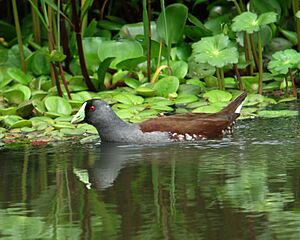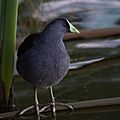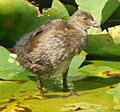Spot-flanked gallinule facts for kids
Quick facts for kids Spot-flanked gallinule |
|
|---|---|
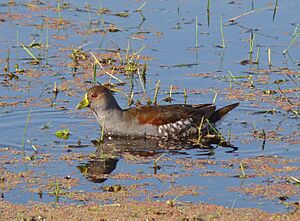 |
|
| Conservation status | |
| Scientific classification | |
| Genus: |
Porphyriops
|
| Species: |
melanops
|
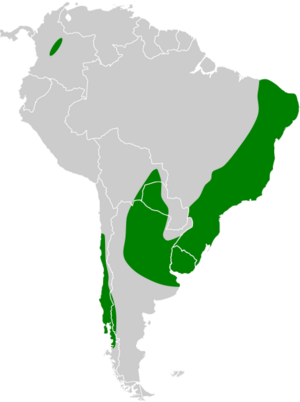 |
|
| Synonyms | |
|
Gallinula melanops |
|
The spot-flanked gallinule (Porphyriops melanops) is a type of bird that belongs to the Rallidae family. It's the only species in its group, called the genus Porphyriops. You can find these birds in many South American countries. These include Argentina, Bolivia, Brazil, Chile, Colombia, Paraguay, Peru, and Uruguay.
These birds naturally live in swamps and freshwater lakes. But they can also live in man-made ponds if they are looked after well. Sadly, their numbers have gone down a lot in recent years. The spot-flanked gallinule has a special W chromosome that is bigger than its Z chromosome. This is very unusual for a bird!
Contents
What Does the Spot-Flanked Gallinule Look Like?
The spot-flanked gallinule is a small bird, often described as looking like a small waterfowl. It usually weighs between 154 and 225 grams. It is about 28 centimeters long.
Its head, chin, neck, and chest feathers are a dark gray color. This color stands out against its black forehead and the top of its head, which goes down to its neck. The feathers that cover its wings are a brown, cocoa-like color. Its main wing feathers are a bit darker brown.
As its name suggests, the sides of this bird's body are brown with white spots. Its back is a mix of the same brown and white shades. Young gallinules look different. They are usually all black before they grow brown feathers and other adult features.
One very noticeable thing about this bird is its pale green beak. This is why it's often called the Green-Billed Tingua in Spanish. Its beak starts black and pink when it's young and turns green as it gets older. Its legs are a dull green-gray color. You don't often see its legs because it spends most of its time in the water. Its eyes also change color. They start black when it's young, then turn different shades of brown, and finally become a bright red when it's an adult.
Where Do Spot-Flanked Gallinules Live?
Spot-flanked gallinules live in both natural and man-made places. They really like decorative lakes, artificial ponds, and natural wetlands. You can also find them in smaller areas with plants growing out of the water or in grassy parks.
These birds are found across South America. Larger groups of them live in Brazil, Argentina, Chile, Paraguay, and Uruguay. A special type of this bird, called P. m. bogotensis, lives only in Colombia. This group is separate from the other gallinule populations that breed.
How Do Spot-Flanked Gallinules Behave?
Sounds and Calls
The spot-flanked gallinule can make many different sounds. These sounds can change depending on where the bird lives. It often sounds like it's cackling, making a "ke-ke-ke-ke" sound. It also has another quick clicking call.
Its song includes the high-pitched "ke-ke-ke-ke" cackling sound. It also makes a low-pitched whooping sound.
What Do Spot-Flanked Gallinules Eat?
The spot-flanked gallinule eats both plants and animals. This means it has an omnivorous diet. It eats plants like Polygonum acuminatum and horsetail paspalum (Paspalum repens). These plants are common in wetlands. It also eats animals, especially snails (from the Planorbidae family) and a few types of insects.
They find their food while swimming. They often look for food among plants that are floating or rooted in the water. Some studies found that gallinules in Colombia eat insects, snails, and seeds. They also eat completely different plant species than the gallinules in other parts of South America. These birds might prefer certain foods depending on what's available. But they especially like Leptospermum laevigatum and sesame seeds.
Reproduction and Life Cycle
Both male and female spot-flanked gallinules help build the nest and care for their young. Usually, only one pair of breeding birds is found per body of water. Nests are typically made from branches, fresh and dry leaves, and sometimes feathers.
They build their nests very close to the water's edge, or sometimes even above the water. The nests are hidden and protected by thick plants around them. A nest can hold about three to six oval-shaped eggs. These eggs are cream-colored with dark brown spots towards the bottom.
Both parents take turns sitting on the eggs to keep them warm. They will often call out to the parent on the nest with a cackling sound when it's time to switch. The parents continue this routine for 18 to 20 days until the eggs hatch. After hatching, the parents feed and protect the chicks for about 50 days. But the chicks can swim and dive very well just a few hours after they are born!
Images for kids



